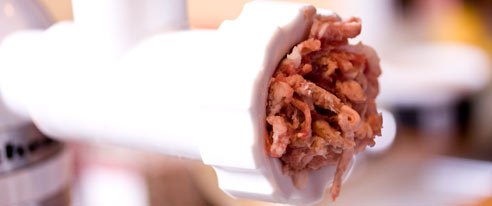Steps
in Making Sausages
Sausage making has been used for hundreds of years to
preserve meat.
Comminution (Particle Reduction) Comminution is the process
by which meat is ground, chopped, diced, emulsified, or reduced to minute
particles for incorporation into sausage.
Grinding: Lean meat and fat are ground to form a uniform
mixture separately by using a machine which has screw, rotating blades and the
grinder. The size of the holes determines the final product thickness.
·
Mixing: Cylinder of fat and meat are mixed
together to form a homogenous mixture.
·
Chopping: It is done in a machine which has a
metal bowl and a rotating knife also called as Silent Chopper or Flier. RPM
(Rotation Per Minute) of bowl and speed can be adjusted as per the required
texture.
Emulsification - If a meat mixture is comminuted with salt in
a bowl chopper or silent cutter, a finely chopped sausage batter is formed. In
the presence of salt a meat emulsion can be formed. In meat emulsions, lean
meat and fat particles are dispersed in a complex of water, proteins, cellular
components, and a variety of spices and seasonings.
Blending - Ground meat or chopped meat, but not meat
emulsions, can be placed in a mixer/blender to evenly distribute the lean and
fat particles and any cure ingredients that are in the mixture. After
blending, the mixture may be added to the revolving metal bowl of a chopper,
where rotating knife blades cut through the meat mass and mix in seasonings
and other ingredients. In this application, time in the bowl chopper is
short and emulsification is not the desired result. After a short time in the
chopper, meat to be used in ground products goes directly into the stuffer to
be formed into sausages.
Forming - Some processed meat products, such as fresh
pork sausage, may be sold in bulk, in chubs or formed into patties. Others are molded into loaves, but most are stuffed into casings. Emulsified sausage stuffing/filling
is also called as sausage dough or batter mince which is transferred into a
Stuffer for filling into casing. Comminuted products are placed in casings to
give them a characteristic shape (like that of a wiener), to hold the product
together, and to allow for further processing.
Tying - According to the type of meat product and the
particular casing, the sausage may be tied at each end with string or
fastened with metal clips. With smaller sausages, such as frankfurters casings
are normally twisted or draw together either by hand or mechanically to produce
links as identical in shape and size as possible.
Smoking: All
sausages are not smoked (with artificial casings). It is the last step in which
the sausages are smoked in smoke-trolleys or tree.
Packaging: After smoking, they are
sent for packaging.






Informative one. !!
ReplyDeleteThank you for information sir
ReplyDeleteThanku sir
ReplyDeleteThankyou sir
ReplyDeleteThank u sir
ReplyDeleteThank you for sharing your knowledge with us sir
ReplyDeleteVery informative
ReplyDeleteThank u sir
Best notes 👍
ReplyDeleteBest notes 👍
ReplyDeleteThank you for the notes sir
ReplyDeleteTanvi
Thankyou sir
ReplyDeleteThank you for the notes
ReplyDeleteRegards- varchasva bhardwaj
Nice notes sir
ReplyDeleteGood information and well explained thanku sir
ReplyDeleteRegards - Yash Bhardwaj
Thanks for the notes.
ReplyDeleteNice
ReplyDeleteGood notes 📝
ReplyDelete